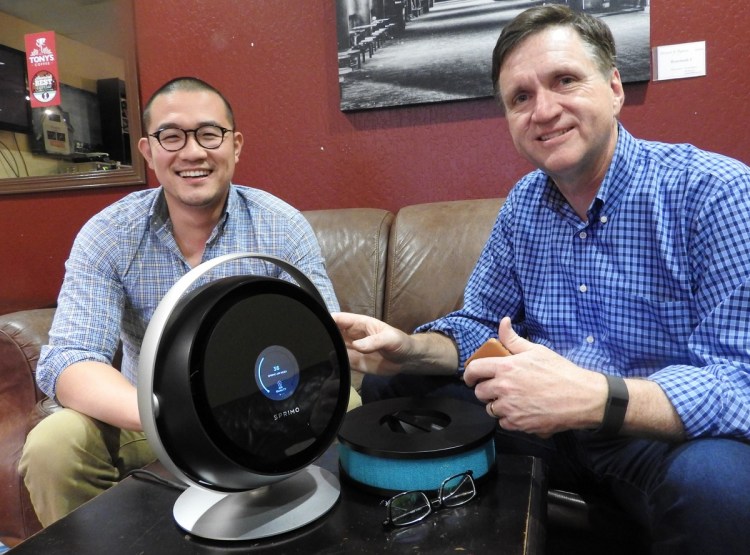Air purifiers haven’t been very smart in the past, and they haven’t really cleaned the air around you. But Sprimo is out to change that with a smart personal air purifier that is engineered to tell you exactly what’s in the air you’re breathing.
The Sprimo has a fan and a filter, like most air purifiers, but it differs in that it is personalized. It is designed to blow a bubble of clean air around your head. What’s more, there’s an indicator on its touchscreen display that tells you just how clean the air surrounding you is. If the light is blue, the air is fine. If it’s yellow, it’s OK. And if it’s red, then there’s something bad in the air you’re breathing. The Sprimo always gives you a number from 0 to 100 telling you the rating on the air.
Because of its design, the Sprimo can be much more efficient at cleaning the air you breathe than whole-room purifiers, which may take hours just to clean a small percentage of the air around you, said Harold Han, cofounder and chief technology officer of Sprimo, in an interview with VentureBeat. The device has an interchangeable air filter (which can be customized for your room) that you can send back to the company for an exact analysis of what is in the air you are breathing. That report may tell you your room has cockroach allergens or dust mite allergens. Over time, with a lot of these in place around the world, Sprimo may be able to figure out who has the cleanest air in the world — or the dirtiest.

Above: Sprimo has a touchscreen that tells you how clean your air is.
The Santa Clara, Calif.-based company is launching a crowdfunding campaign today to raise $250,000 on Crowd Supply. It hopes to launch the $400 device in early 2017. I think it is a fascinating idea on a bunch of levels. Ray Combs, CEO of Sprimo, said in an interview that the bubble of air around you is all that you really need. And Sprimo can create that bubble of fresh air because of its unique air flow design.
“We believe we are 50 times more efficient at clean-air delivery than whole-room purifiers,” he said. “If your indicator says 100, the air is perfect. If it’s 9 or 10, it’s a bad day. We focus on delivering you a bubble of clean air.”
The fan is quiet, and the filters can be recycled. In fact, an indicator on the display can tell you exactly how many days of life you have left in the filter before you need to change it. You can also see how much capacity the filter has for dust or gas filtration. You can simply twist and pull a filter to take it out and change it.
You can also figure out what kind of custom filter to use. If you live in an area with lots of pollen, you can use a specific kind of filter during the spring. In the winter, you can use another kind of filter. It can be a mix of a High-efficiency particulate arrestance (HEPA) or carbon filter. The fan doesn’t have a propeller because, while such fans are great at pushing air, they’re not good at pulling it in.

Above: Sprimo has an easily replaceable, customizable filter.
It’s certainly not cheap (the early bird price is discounted at $300), but it goes beyond standard filters. Sprimo can connect to Wi-Fi and Bluetooth, and it runs the embedded Linux operating system. It has a particulate matter (PM2.5) sensor and a carbon dioxide sensor, as well as sensors for volatile organic compounds (VOC), humidity, and temperature. Its Gimbal design was created by cofounder Dan Harden, who designed products such as Google Chromecast, Nike Fuel, and Dropcam. It has a solid aluminum frame base, weighs 7.5 pounds, and it can be tilted up or sideways.
Combs has worked on products such as the Palm Pilot, Amazon Kindle, and Livescribe smartpen. Han has a doctorate in chemistry from New York University, and he was a senior researcher at Bio Rad. He got the idea while traveling with Combs in China. They found that the air was really polluted, and Han said that two members of his close family had died from lung diseases.
“We wanted to address this problem and do something useful,” Combs said.
Current purifiers often purify only about 1 percent of the air that reaches you in a room, Han said. The pair received advice from Jovan Pantelic, an assistant professional researcher at UC Berkeley, and Dusan Licina, a post-doctoral researcher at UC Berkeley, about how to design a personal air purifier.
The product can sit on your nightstand or on your desk. It pushes out antigens and pushes clean, filtered air at your face. You can access more information via a mobile app. You can check the quality of the air in your child’s room remotely. And you can check a graph that shows how the air quality in the room has changed over time. The app is integrated with HomeKit and Siri. When the filter’s touchscreen display isn’t being used, it displays the time of day.
The company is small. It has raised about $300,000 in funding, and it has fewer than 10 full-time and part-time employees. Sprimo (which was taken from “spring morning,” or Han’s Chinese name) is seeing a lot of demand from China, where air pollution is a big problem. But even if you don’t live in a highly polluted area, it can help keep you informed about the air around you.
“We saw a spike in the meter when we cooked some fish in the kitchen,” Combs said.

Above: You can easily point a Sprimo air filter in any direction.
VentureBeat's mission is to be a digital town square for technical decision-makers to gain knowledge about transformative enterprise technology and transact. Learn More

